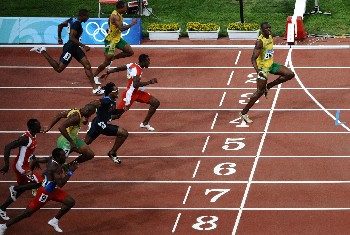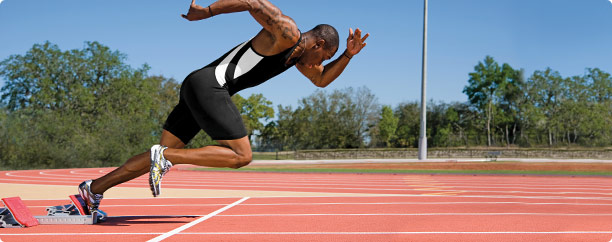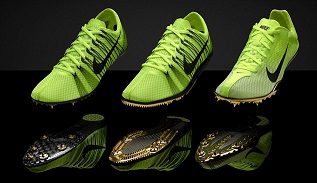Sprints
 The SDAC Sprint Page
The SDAC Sprint Page
This page contains information relating to sprinting and is suitable for any athlete who wishes to improve their speed, strength and power. While the information is quite general, it become more relevant to athletes who are beginning to favour the sprints over other events, are showing competitive promise and who are interesting in training to improve their performances.
The page attempts to answer many common questions that are asked about sprinting and includes links to external instructional videos and articles. Official rules relating to things like sprint spikes and starting blocks are also included.
How does a developing athlete get faster?
Sprinting is a skill and it also requires strength. Getting faster is actually more simple than you might think. You need to practise the skill – by sprint training, and you need to get stronger – by strength training. While there are several technical elements that are important to consider, every athlete will have their own individual styles which should be allowed to develop.
An athlete should learn the correct body positions during acceleration and maximum speed running. They should learn to become relaxed and balanced at high speed. They should learn how to run a bend effectively.
To run faster you need to run fast and often. Depending on your level of ability, you will need to train 1-3 times per week in addition to your Saturday competition. But most importantly you need to have fun while doing this. Sprinters run for the exhilaration of running fast! More information on training for sprinting follows.
Click here for a basic sprint coaching video
Click here to watch a video on understanding sprinting
Click here to watch how to break a world record!
How does a developing athlete get stronger?
All track and field events depend on the athlete’s ability to produce force. Getting stronger allows you to produce more force. The only way to get stronger is by strength training which is exerting your body against a resistance. This involves lifting weights of some sort.
Strength training is suitable for any athlete who is mature enough to follow qualified instruction. There is a myth that strength training is harmful to youth athletes. As long as the strength training is designed by qualified coaches, then it has significant benefits for developing athletes and statistically is much safer than other sports.
Strength training can have an immediate and significant effect on your performance and will make you more resistant to injury.
 The first step in improving performance in any athletic event is to set goals!
The first step in improving performance in any athletic event is to set goals!
You need to have something to aim for – setting goals gives your training and competing some direction. The goal should obviously be an improved performance against what you are currently capable of. The goal should be realistic and it should relate to a certain point in time.
For example, you may wish to reduce your 100m time by 0.5 second by Christmas or be running a 29 second 200m consistently by the Zone carnival. Maybe your goal is to qualify for something.
To help you set some goals, you can look at your personal bests on the website. You can go through past Zone, Regional and State competition results to get an idea of what performances occur in your age group at those levels.
Click here for the results from the State Championships 2015
We have included the Qualifying Standards for the JETS Junior Encouragement Squad and the Australian Junior Championships to give you some idea of what is required to achieve those levels.
Click here for the JETS standards
Click here to see the Australian Junior Qualifying standards
Remember, significant improvements are readily available to any athlete that gets serious about training properly and sets goals. Junior athletes in particular can progress quickly if they haven’t trained before and find opportunities to compete at a higher level (see more on this below).
How often should I train? What should I do?
Assuming that you are competing on a Saturday morning at Little Athletics then twice weekly training will make a big difference – as long as you are training with a plan!
Your training plan should be what is known as progressive – it should be slightly more difficult every week and it should be designed to help you achieve your goals. It should include planned periods where you de-load a bit and it should take into consideration any other sports that you play.
Just running around the track doing repetitions, while not a waste of time, is not effective training. Your training runs should be timed and they should vary in length and speed depending on your goals. You should be working towards training targets.
Here is how training works. You apply a stress to your body (the training) and then you recover from that stress (rest). Then your body adapts to that stress in anticipation of another, higher stress (performance improvement). You then repeat this with more stress. That is why your training needs to be planned and progressive.
Performance improvement is about momentum. It is no good training occasionally or just when you feel like it. Competitive athletes set up a weekly schedule of competition, track training and strength training and they stick to rain, hail or shine!
Speed is a skill so the majority of your training should be done at 90% or more of your maximum speed. Running slow is useful only to build base fitness. You should also practice how you run your race, this is known as race modelling and it is very useful for 400m and 800m athletes.
Sprinting also requires strong acceleration – the only way to get better at accelerating is to practice accelerating (and get stronger). This can be done on track or even on a hill.
There are many wet weather options available if you get creative so you have no excuse not to train! Hill running is excellent, pool running is effective, stationary bikes provide a training stimulus and circuit training in a gym or at home is also effective.
We are more than happy to provide individual training plans to SDAC athletes.
A good sprint training program will include:
Skill practice – maximum speed, acceleration, starting, finishing, relaxation, bend running, race modelling
Energy System Development – depending on your event you need to train for short or long speed endurance or possibly both
Technique – body posture, arm and leg positioning, foot strike
Strength and Power – running is about putting force into the ground. The stronger you are the more force you can produce. The faster you can produce that force the more powerful you will be.
 How do I improve my start? Do I need to use starting blocks?
How do I improve my start? Do I need to use starting blocks?
The only way to improve your start is to practise starts! Over time, you should be aiming to develop at least a crouch start if not a block start. Most importantly, you need to learn how to accelerate from a stationary position in a way that sets up the rest of your race. If you are doing a crouch start with your front foot on the starting line then you are doing it wrong!
Click here to watch a basic crouch start tutorial
You can also practise your reaction to the gun. There are various free phone apps that simulate the starting sequence (on your marks, set and bang) just like a real race. This can even be practised at home in the back yard!
Starting blocks can be used by ages U11 and up and they should be! Starting blocks offer a number of advantages. For athletes who are not yet strong, the main advantage is that they provide consistency in how you set yourself up to start each race. They also stop you “rocking backwards” before you start moving forwards which is common problem with standing starts. Blocks also save wear and tear of the track start area so the more athletes using them the better.
Once you have developed decent strength through strength training, then starting blocks allow you to use that strength by explosively pushing off an immovable object to overcome inertia and get moving. This is where the real advantages lie.
It is best to get proper starting block instruction from a qualified coach so you don’t develop poor habits which are hard to erase.
Here are the Australian Little Athletics rules relating to starting blocks:
5. Starting Blocks
5.1 Starting blocks may be used by competitors in the U11 and above age groups for all races up to and including the 400 metres (including the first leg of all relays).
5.2 Personal starting blocks are not permitted were starting blocks are provided either by the venue or the Organising Committee for the carnival
Note that some school competitions run on synthetic tracks make the use of blocks in the sprint races compulsory.
 Should I wear sprint spikes?
Should I wear sprint spikes?
Spikes should be worn by every athlete aged 11 and up (see rules below). They provide traction and make a significant difference to your sprint times – especially in the start.
The taller the athlete and the longer the grass that they run on the longer the spikes should be. Most spikes come from the store with short synthetic track spikes which are next to useless on grass tracks. You should invest in some longer spikes suitable for grass – 9mm to 12mm are suitable. Synthetic tracks allow a maximum sprint length of around 7mm so those ones that came with your spikes are suitable.
Here are the Australian Little Athletics rules relating to spikes:
4.4 Competitors in the U11 age group may wear spike shoes in events run entirely in lanes, long jump and triple jump
4.5 Competitors in the U12-U15 age groups may wear spike shoes in events run entirely in lanes, long jump, triple jump, high jump and javelin
4.6 Competitors in the U13-U15 age groups may wear spike shoes in all of the events listed in Rule 4.5, as well as in events not run entirely within lanes, except walks.
4.7 Spike shoes with the spikes removed shall not be worn by any competitor in events where they are not able to wear spike shoes
4.8 Spike shoes must only be worn during an event and are not to be worn to and from an event
4.9 Any number of spikes up to 11 may be accommodated on each shoe, but the number of spike positions shall not exceed 11
4.10 Spike length (subject to any further constraint from ground policies):
a. Synthetic -Track 7mm maximum, Long/Triple/High/Javelin 9mm maximum,
b. Grass -Track /Long/Triple/High/Javelin 12mm maximum
What other opportunities exist for SDAC athletes to get faster?
There is no better way to improve your competition performance than by going in competitions!
While Saturday morning Little Athletics is great fun, running on a grass track and being timed manually by hand held stop watches does not give you an accurate reflection of your true performance.
Whenever possible, the serious sprint athlete should seek out additional competition. The EXPERIENCE that is gained by doing this is very important when it comes to Zone, Regional and especially State level competition. Overcoming nerves, practising setting up blocks, learning to how to warm up at the right time and meeting new people who also love to sprint are all benefits of doing this.
Fortunately, these opportunities exist.
SDAC athletes should become “dual registered”. This costs nothing and allows you to compete in Athletics NSW events.
These are events are usually “seeded on times” so you will only ever compete against people in your age group of similar ability. (Some athletes purposefully seed themselves into faster races as this can provide a significant competition effect).
The main competitions prior to Christmas are the Treloar Shield events which are effectively a club V club completion. SDAC Athletes would become dual registered as Blue Mountains Athletes for these events. Blue Mountains has a proud history of competing at these events and punching well above their weight!
These are held on Saturday afternoons ate the various synthetic tracks around Sydney and we always have athletes attend. Please contact us for more information and click here to read more from the Athletics NSW Website.
After Christmas, the opportunities include the Allcomers Series and the various Youth and Junior Competitions. Click here or contact us for more information.
What else do I need to think about to get faster?
Warm up: Warming up properly before a sprint training session or race is essential. Not only to help avoid injury but also to maximise performance. A warm up should take at least 15 minutes but not tire the athlete out at all. They should feel ready to go!
Injury Management: Injuries do happen and are a part of normal physical development. It is important to seek qualified advice on how to treat and manage injuries as soon as they happen. Strength training and warming up will help protect athletes of all ages against injuries.
Recovery: Most serious sprint athletes are guilty of overtraining not undertraining! Recovery between sessions is essential or else you will not get faster. Try to limit the number of days in a row that you train or compete at 100% intensity (flat out sprinting). Ideally there should be 48 hours between sessions but this is not always possible, especially in competitions.
If competing in a weekend long competition such as All Schools, Zone, Regional or State for example, then your overnight recovery is very important. Warming down, stretching overnight, alternating hot/cold water immersion or showers, staying warm, hydration and nutrition will all make a significant difference to your performance.
Nutrition: You are what you eat. If you eat junk then your body will repay you with sub-standard performances and low energy. If you eat well, then your body will reward you with lots of energy, an improved immune system so you can train harder and more often and a higher response to training effort.
Mindset: Sprint races are won and lost by a fraction of a second. Usually, it is the will to win that makes the difference. Having a positive and confidence mindset is essential. Training hard will give you the confidence. Enjoying what you do will keep you positive.
Now go sprint.
